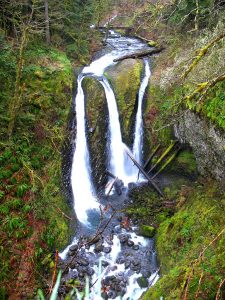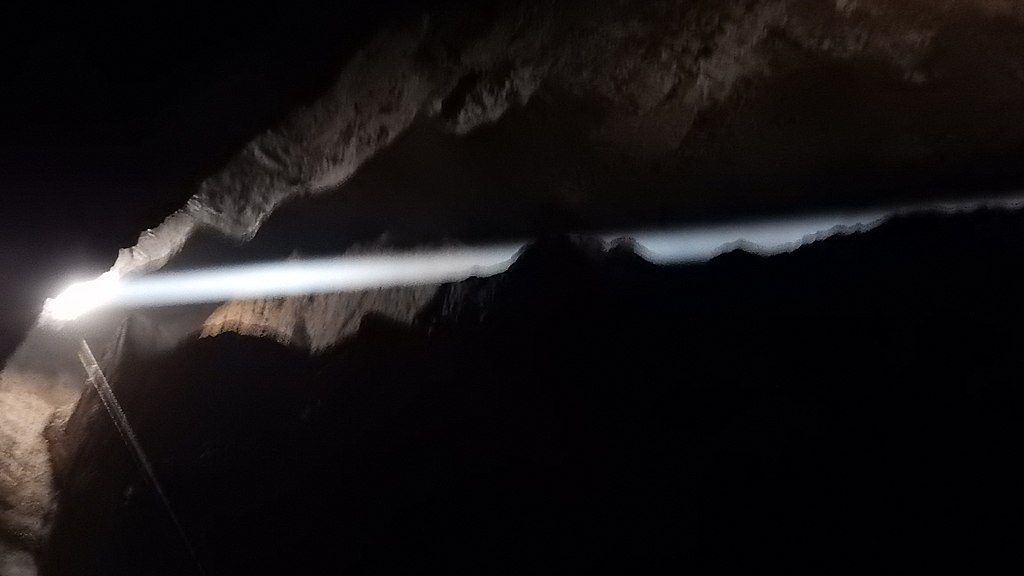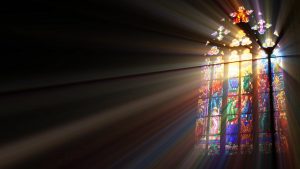On Sunday, February 11, 2018, the Rev. Dr. Arthur Suggs continued with — as he said — “a series of sermons on primal archetypes that wind their way through the scriptures, bend their way through the world’s religions, and churn their way through our lives.
First in the series was trees, the second was mountains, the third was light, the fourth was music, and this sermon explores the archetype of water.”

Flying over an Archetypal Symbol, I Am Disconcerted by the Absence of Terra Firma.
I had a marvelous experience a number of years ago when a friend of mine who is a pilot had a three-day meeting in San Juan. He asked me if I could take three days and go with him. He lived in Kansas City, so he flew his four-seat airplane to the Binghamton regional airport, picked me up, and then we flew down to Miami, crossing over Washington, D.C., airspace, where I learned they’re rather picky about that.
We landed in Miami and were told we needed to pick up a little box that went at my feet, which was an inflatable life raft in case things go bad. That was at my feet as we left Miami heading for San Juan, Puerto Rico. Shortly after taking off, we flew at 7,000 feet, and the big planes were at 40,000 feet, zooming past us as we puttered along.
We were not far out, just 15 minutes out of Miami, when I fully realized there was no land in sight. Wherever I looked, there was nothing but ocean, and it stayed that way for quite a while. It was a little disconcerting being in a tiny airplane, and a little statistic came to mind — three-quarters of the earth is covered with ocean.
Suddenly, it seemed like a lot of water.
What I’m going to do is to give you two brief overviews, and then to look in detail at two passages from the Bible, which happen to say the same thing.
Two overviews first: The symbolism of water is huge.
It’s everywhere, and so what I’d like to look at is the concept of dream symbolism.
You see a waterfall, for instance, or a geyser or a river in your dreams. What does that mean? There are symbols, meanings that go with images of water. Here are a few of them:

Symbols of Dreams About Various Kinds of Water
Ice — For example, if you dream about ice, there’s a situation in your life that’s frozen or static and needs to be thawed out.
Muddy or murky water — The situation is unclear and needs to be clarified.
Splashing water — There’s a need for arousal, for awakening.
Steam, vapor, mist, fog — Not all has been revealed; not all is known.
Ocean — A classic symbol of infinity. Either standing on a beach and looking out as far as the eye can see or flying in an airplane gazing in any direction.
Tides — Are symbolic of the natural rhythm of things. Beyond that, there’s a powerful rhythm. In other words, it’s foolish to fight against it.
Snow — Represents quiet and peace.
Flood — This is a complex image because it’s both bad and good. It means too much, to the point of danger. It means damage and loss, but it also means judgment. In addition, it means destroying in order to purify.
Spring rains — Mean warmth, growth, softening, renewal.
Lake — This is also complex. It means unrealized potential because you see only what’s on the surface, and there’s so much underneath that has yet to emerge.
Puddle — Symbolizes play, childhood, fun, carefree; go ahead and get dirty.

Stream, river — Another symbol for infinity; ever flowing, never stopping.
Oasis — Water in the desert; a place of safety or refuge, away from danger.
Well — One of the most extraordinary symbols of all. Like the ocean or the stream, it’s one of the most pregnant symbols of all time. Its meaning is to go deeper to find life-giving water. Go deeper in sports, meaning to try harder. In our intellect, in our spirituality, going deeper to find nourishment, to find reward.
These are only a few examples of water symbols — 14 of them if you were counting, out of dozens and dozens.
Overview Number Two — Classic Bible Texts Concerning Water
The second overview on water is to look at these classic texts in the Bible about water, that reference water — the same profound and important things, using water as imagery. Let me give you a handful of these:
Genesis 1:1 — “In the beginning when God created the heavens and the earth, the earth was a formless void and darkness covered the face of the deep, while a wind from God swept over the face of the waters.”

This is a philosophical passage. That primal, chaotic, formless potential that God’s spirit swept over in order to begin creation. It’s a poetic way of wording it. Some of the other texts are a bit tough.
Amos 5:21 and 23-24 — Fantastic imagery but extremely judgmental. God is speaking, “I hate, I despise your festivals, and I take no delight in your solemn assemblies. // Take away from me the noise of your songs; I will not listen to the melody of your harps. // But let justice roll down like waters, and righteousness like an everflowing stream.”
Jeremiah 2:12-13 — An equally judgmental passage. “Be appalled, O heavens, at this, be shocked, be utterly desolate, says the Lord, // for my people have committed two evils: they have forsaken me, // the fountain of living water and dug out cisterns for themselves, // cracked cisterns that can hold no water.”
John 7:37 — “On the last day of the festival, the great day, while Jesus was standing there, he cried out, ‘Let anyone who is thirsty come to me, and let the one who believes in me drink. As the scripture has said, “Out of the believer’s heart shall flow rivers of living water.” ’ Now he said this about the Spirit, which they were to receive . . . .”
Download the Full Sermon: All Wet – Water in Scripture
Featured Image Credit: Clouds over the Atlantic Ocean, Brazil. By Tiago Fioreze, CC Wikimedia.






